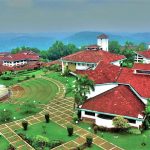CLAT 2025 GK PAPER ANALYSIS
with 50 Most Important topics for CLAT 2026 Exam
The CLAT 2025 GK paper analysis is crucial to understand the overall structure and focus of the exam.It helps evaluate the difficulty level, coverage of topics, and the proportion of static vs. current affairs.GK is a high-scoring and time-efficient section, making its analysis vital for effective preparation strategies.Identifying recurring themes and evolving question styles supports future aspirants in prioritizing study areas.The analysis also enables teachers, mentors, and institutes to refine preparation plans for upcoming test-takers.
CLAT 2025 GK PAPER: Passage-wise Domains and Sources
| Passage Topic | Domain | Source(s) | Type | Reason |
| Nari Shakti Vandan Adhiniyam, 2023 | Indian Polity, Gender, Legislation | Rudolf C Heredia (2012); Soumya Bhowmick (2023); CLAT paper framing | Mostly Objective | Legislative developments, factual plus commentary |
| Paris Olympics 2024 | Sports, International Current Affairs, Pandemic Impact | NBCNEWS media report (revised for CLAT) | Mostly Objective | Factual reporting and analytical context |
| Civil Disobedience Movement, Industrialists & Workers | Modern Indian History, Freedom Movement | NCERT textbook, “India and the Contemporary World,” Ch II | Mostly Objective | Historical facts, participant actions |
| BRICS Summit, Xi-Modi meeting | International Relations, Economics, Geopolitics | Reuters news report, Vladimir Soldatkin & Guy Faulconbridge (2024) | Mostly Objective | Event details, geopolitical commentary |
| J&K Article 370, Reorganization, Ladakh | Indian Polity, Geography, Legislation | Press Information Bureau, Union Home Ministry (2019) | Objective | Legal and administrative factual narrative |
CLAT 2025 Exam paper: What was asked?
- Indian polity and gender (e.g., Women’s Reservation Bill/Nari Shakti Vandan Adhiniyam) sourced from editorial commentary and contemporary policy analysis.
- International current affairs, especially sports (e.g., Paris 2024 Olympics) sourced from media outlets like NBCNEWS.
- Indian modern history (e.g., Civil Disobedience Movement) using excerpts from NCERT textbooks.
- International relations and geopolitics (e.g., BRICS summit) using reporting from agencies like Reuters.
- Indian constitutional changes and territorial reorganization (e.g., Jammu & Kashmir), based on governmental press releases and the Home Ministry.
Pattern: The CLAT continues to use authentic, reputable sources (news media, academic texts, government notifications, and policy analysis articles). This ensures a mix of factual accuracy and discursive writing styles. Such choices demand that candidates develop the ability to read dense but accessible real-world texts rather than just synthetic exam material.
| Passage |
Question |
Direct from Passage |
Logic Possible |
Info Required |
Question Text |
| 1 (Polity) | 25 | True | True | True | The Nari Shakti Vandan Adhiniyam 2023... |
| 1 (Polity) | 26 | True | False | False | As per Rudolf Heredia women's political leadership... |
| 1 (Polity) | 27 | True | False | False | According to Soumya Bhowmick the quotas... |
| 1 (Polity) | 28 | True | False | False | The amendment to Art. 330a & 332 aims... |
| 2 (Olympics) | 29 | True | False | True | India won a back-to-back Olympics hockey medal at... |
| 2 (Olympics) | 30 | True | True | False | Peculiarity of the Paris Olympics 2024... |
| 2 (Olympics) | 31 | True | True | True | Which incident supports the 'troubling geopolitical backdrop'... |
| 2 (Olympics) | 32 | False | True | True | Which one is true? (mixed GK and inference) |
| 2 (Olympics) | 33 | False | False | True | Highest Olympic medal tally for India... |
| 2 (Olympics) | 34 | True | False | False | Where is the opening ceremony of the Paris Olympics held... |
Explanation of Columns:
- Direct from Passage: The answer is textually present in the given passage.
- Logic Possible: The answer can be reasoned out via logic, even if an exact fact isn’t remembered.
- Info Required: The answer requires specific information (either from the passage or prior knowledge).
- Question Text: Paraphrase of the actual question.
10 Full length current affairs including General knowledge test: Click Here
Exclusive Clat Test Series at Discounted Price
Tricks for option elimination:
- Many questions are constructed so that careful, close reading of the passage is rewarded—literal answers can be found or deduced.
- Options often include “None of the above” or “All of the above.” In some cases, candidates can use logical elimination to guess correctly, even without full-detailed knowledge.
- Still, several questions (especially those about medal counts, constitutional articles, or specific historic events) are purely fact-based and require information either directly supplied in the passage or strong background knowledge.
- Questions following subjective passages (commentary, op-eds) require understanding of tone, critique, and inference beyond explicit facts.
| 50 Important Topics for CLAT 2026 Current Affairs & General Knowledge |
Indian Polity and Governance
- Women’s reservation and Nari Shakti Vandan Adhiniyam 2023
- Constitutional amendments related to reservation (Articles 330a, 332)
- Structure and powers of Lok Sabha and State Legislative Assemblies
- Implementation challenges of social justice legislations
- Reservation policies for Scheduled Castes, Scheduled Tribes, and women
- Details on Jammu & Kashmir Reorganisation Act, 2019
- Abrogation and impact of Article 370
- Union Territories with Legislative Assemblies
- Capital cities and administration of newly formed Union Territories (Ladakh, J&K)
- District reorganizations in J&K region post-2019
- Functions of Rajya Sabha and cultural diversity issues
- Role of Women in Indian Politics and related constitutional protections
Indian History and National Movements
- Civil Disobedience Movement and its phases
- Role of Indian Industrialists during freedom struggle
- Participation of working class and women in freedom movements
- Impact of Gandhi’s Salt March
- Formation of Indian industrial and commercial organizations (FICCI, etc.)
- Economic nationalism and protectionism in freedom struggle
- Round Table Conferences and their outcomes
- Key mass movements supported by industrialists
International Affairs and Diplomacy
- BRICS summit developments and India-China relations
- Global economic blocs and currency alternatives to USD
- Geopolitical impacts of the Russia-Ukraine conflict
- Israel-Hamas conflict and international responses
- Role of international organizations and alliance politics
- Impact of global summits on India’s foreign policy
Sports and Culture
- Paris Olympics 2024 overview and key facts
- India’s medal tally and performance highlights in recent Olympics
- Historical Olympic achievements of India (Neeraj Chopra, Manu Bhaker)
- Impact of Covid-19 on international sports events
- Significant cultural rituals and ceremonies in global sporting events
Environment and Wildlife
- Conservation initiatives (Big Cats Alliance and similar international efforts)
Economy and Trade
- Economic reforms and trade-related movements during freedom struggle
- Alternative international payment systems announced by BRICS
- Influence of economic sanctions and trade embargoes in global conflicts
- Emerging markets and their global economic impact
Science and Technology
- Application of artificial intelligence in governance and economy (mentioned in BRICS communique)
Legal and Constitutional Developments
- Important Supreme Court rulings related to Union Territories and governance
- Legal provisions around GST and taxation in special regions (J&K)
- Legislations related to political participation of minority groups
Current Affairs Update Preparation Strategy Topics
- Analytical reading of policy critique articles
- Understanding descriptive vs. substantive representation in politics
- Role of grassroots changes vs. top-down policymaking
- International relations theory and its application to current Indian diplomacy
- Reading and analyzing government press releases and PIB articles
Geography and Administrative Structure
- States and Union Territories count and related administrative details
- Capitals and administrative divisions of Indian Union Territories
- Historical changes in territorial governance post-independence
- Mapping of new district formations in various states and UTs
- Key Indian rivers and cultural sites relevant to national major events
Also Read: CLAT 2026 Preparation Guide: Syllabus, Exam Pattern, Strategy & 60 Days Master Plan
Related Blogs:
CLAT 2025 Exam Question Paper pdf download
CLAT 2026 Preparation Guide: Syllabus, Exam Pattern, Strategy & 60-Day Master Plan
CLAT 2025 Previous Year Paper: English Section Analysis
CLAT 2025 GK Paper Analysis | 50 Important Topics for CLAT 2026 Preparation
10 Current Affairs including General knowledge Free Mock
Exclusive Clat Test Series at Discounted Price




